Research results of scientists and specialists. Рубрика в журнале - Nanotechnologies in Construction: A Scientific Internet-Journal
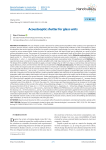
Acoustooptic shutter for glass units
Статья научная
Introduction. The use of liquid crystals is attractive for solving technical problems when creating a new generation of monitors, pressure sensors, seismic activity, determining the level of dry or liquid media, indicators of the concentration of harmful substances due to the small size of devices, low power consumption, simple design, low cost, and easy controllability of liquid crystals by various external fields. Under the action of mechanical shear, the liquid crystal layer is deformed, as a result of which surface polarization occurs. The purpose of the research is to conduct an experimental study of the effect of an electric field on flexopolarization occurring in a thin layer of a liquid crystal to create an acousto-optic shutter. Materials and methods. Nematic liquid crystals 10 – 100 μm thick with homeotropic orientation of molecules were used as materials: n – methoxybenzylidene n – butylaniline; 4 – octyl – 4 – cyanobiphenyl; nitrophenyloctyloxybenzoate; cyanophenyl ester of heptylbenzoic acid. Methods. The experimental setup consisted of a charge-sensitive amplifier with a high input resistance of 10 GΩ and a selective amplifier (2 MΩ). The design of the amplifier made it possible to apply a constant voltage of up to 100 V to its input, as well as linear and synchronous signal detections, which were then fed to the ADC that recorded them. Results and discussion. The behavior of charges induced on the surface of a liquid crystal due to internal mechanisms of molecular-orientation polarization was considered as a function of the magnitude and direction of the external electric field. For this, a liquid-crystal layer (MBBA) was placed in an electric field. The dependences of the first U1ω and second U2ω harmonics, when a positive potential is applied to a deformable plate, reach lower values than with a negative one. The electric field at a positive potential stabilizes the molecules of the polarized layer, and at a negative potential it makes it less stable, which leads in one case to a decrease in the slope angle on the surface, and in the other to an increase, which leads to an increase in the second harmonic. Under weak boundary conditions, a polar deformation occurs in the bulk of the NLC. When the field is applied to the homeotropic layer of NLC (CPEHBA), the value of the second harmonic U2ω increases linearly from the voltage Uc up to the achievement of “saturation”, which is due to an increase in the stabilizing dielectric moment over the viscoelastic one. At low fields (Е ≤ 104 V/cm), the value of U2ω first increases and then decreases due to an increase in the tilt angle of the director relative to the normal to the surface. At low polarizing voltages Uc ≤ 15 V (CPEHBA) dependence U1ω is approximated by a power function of the Uc 3 type, at Uc >> 15 V the second harmonic U2ω depends as Uc –1. At low bias voltages, the position of the minima of the values of the first U1ω and second U2ω harmonics (for MBBA and CPEHBA) does not coincide with the zero point along the abscissa at Uc = 0. The harmonics U1ω and U2ω have a maximum when a positive potential is applied to the moving electrode. In the region of positive displacement voltages, the molecules stabilize, while at negative voltages, the molecules are less resistant to orientational perturbations. The value of the second harmonic U2ω sharply decreases with the perturbation frequency. Conclusion. The obtained research results can be used in the development of pressure sensors, seismic sensors for buildings and structures, light modulators, as well as an acoustooptic switch for glass units.
Бесплатно
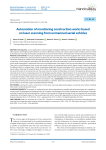
Automation of monitoring construction works based on laser scanning from unmanned aerial vehicles
Статья научная
Introduction. Current publications and technologies for digital modeling of construction projects often entail considerable expenses and lengthy project timelines. In order to effectively monitor and control a large number of objects, there is a need to develop laser scanning technologies specifically for unmanned aerial vehicles, eliminating the need for ground-based imaging. Materials and methods. The study employed a hexacopter-type unmanned aerial vehicle equipped with a laser scanner, as well as specialized software for processing aerial imagery and laser scanning data, which included tools developed by the authors. The octant method was utilized when developing an algorithm for point cloud comparison. Results and discussion. In the course of the study, a technology for automating the monitoring and control of construction work was developed, in accordance with which aerial photography is performed once and an orthophotomap of the object is built (to accommodate laser scanning data). Then, with a certain frequency, laser surveys are carried out from an unmanned aerial vehicle, dense clouds of points are formed for different dates. To compare them, a linear computational algorithm has been developed, which, using data on two dense point clouds, allows obtaining the resulting cloud, which reflects the progress in the construction work. A feature of the algorithm is that the search for points is not carried out over the entire cloud, but within the boundaries of octants. This speeds up data processing and reduces the load on computing power. The technology received software implementation in the web application “Management system for monitoring construction work at facilities that have passed the state examination.” It allows the user to quickly get a visual representation of the change in the construction object for the selected period, to carry out all the necessary measurements (coordinates, geometric parameters, material consumption, etc.). Conclusions. The developed technology for automating the monitoring of construction work can be used by developers, customers, state and municipal authorities to quickly obtain information in order to control and support managerial decision-making.
Бесплатно

Статья научная
Introduction. Approximately 20% of accidents in buildings and structures are associated with the destruction of metal structures. Nanocoatings applied to metal structures significantly improve their operational properties, but at the same time make it difficult to use traditional non-destructive testing methods that require access to the surface of the base metal. The quality of the nanocoating is controlled during its formation. To prevent the destruction of metal structures, it is necessary to identify structural heterogeneities of the base metal in micro- and sub-micron sizes, which arise in areas of increased mechanical stress concentration and transform into macrodefects leading to structural failure. Methods and tools are required to non-destructively identify the stress-strain state and damage of the base metal structure through the layer of nanocoating. Electromagnetic-acoustical (EMA) transformation, is considered promising for solving this problem. Existing EMA tools do not fully utilize the potential of EMA conversion, have insufficient sensitivity and the lack of informativity. Methods and materials. For experimental research, we selected widely used in construction structures steels. Research was conducted on the interrelationship of structural alterations in standard samples of metals and the parameters of the electro-magnetic (EMA) transducer under static and cyclic loads. Results. Load diagrams of metal samples were obtained, with accompanying photographs of microstructure in control points, along with their frequency models derived through spectral analysis of the signal from EMA transducer. Discussion. Changes in the stress-strain state of the metal and accumulation of damage in its structure result in a complex interrelated set of changes in mechanical, acoustic, and electro-physical properties, all of which are reflected in the changes in the parameters of the frequency model. Conclusion. Based on the results of the conducted research, the use of a frequency model has been proposed as an integral parameter for identifying the stress-strain state and damage of metal in the equipment. The use of an artificial neural network for analyzing frequency model parameters simplifies the process of identifying the stress-strain state and damage of metal structures and increases its reliability.
Бесплатно
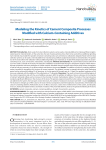
Modeling the Kinetics of Cement Composite Processes Modified with Calcium-Containing Additives
Статья научная
Introduction. Rock wastes from dust collection systems can be used as mineral additives for making artificial conglomerates based on mineral binders. At the same time, the size of waste particles allows them to be used without additional grinding. Such materials may include fine powders of calcium-containing rocks such as limestone, wollastonite, diopside. Waste rock from dust collection systems can be used as mineral additives for manufacturing artificial conglomerates based on mineral binders. The particle size of the waste allows their utilization without additional grinding. Such materials can include finely dispersed powders of calciumcontaining rocks, such as limestone, wollastonite, and diopside. Methods and materials. We used Portland cement CEM II/A-W 32.5F was used as a binder in the study. The selection of additives was determined through a comparative analysis of their thermodynamic properties with those analogous to clinker minerals. Standard research methods were used to study cement composites, as well as mercury porometry, X-ray phase analysis and electron microscopy. Results. The addition of calcium-containing additives makes it possible to strengthen the structure of cement materials. The greatest increase in strength during the initial hardening period can be achieved by adding 2% of limestone. In the late period of strength gain (in 14 days), the greatest hardening of the stone was obtained with the addition of 9% wollastonite or 7% diopside. Discussion. The results of cement stone diffractogram of the control composition and with the use of additives are given. With the addition of additives, there is a decrease in the intensity of calcium hydroxide reflexes and an increase in the intensity of calcium hydrosilicates reflexes. The study of the macrostructure revealed a significant difference in the structure of the stone. The porosity analysis showed that when calcium-containing additives are added into the system, the total pore volume decreases, the number of small pores increases (size 0.003–1.2 μm). Conclusion. The increase in strength up to 48% is due to the close chemical composition and thermodynamic characteristics of the binder and calcium-containing additives. Wollastonite, due to its fibrous structure, creates micro-reinforcement of the system, and diopside, in its turn, having the highest hardness and elastic modulus of the presented additives, leads to the greatest hardening of the stone.
Бесплатно
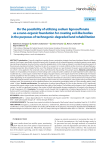
Статья научная
Introduction. Currently a significant number of quarry restoration strategies have been developed, based on different aspects of soil impact: specifically, mixing the topsoil with the empty rock of exhausted quarries; introducing organic waste; applying mulching and polymer structure formers; using the adapted plants. In this study we attempt to combine the positive aspects of the previously mentioned methods. Therefore, the aim of our research is to create artificial soil-like structures with specified agroecological properties. We anticipate further use of the obtained mixture as a layer between the quarry waste material and fertile soil, which is to be applied to the reclaimed surface and followed by the planting of local plant species. Materials and methods. Studies on the possibility of reclamation of mine tailings were conducted under conditions of model experiment with sodium lignosulfonate (SL), a waste organic material from the pulp and paper industry, as the organic base for the soil-like body. Fine fraction soil (FS) sampled from the mine tailings was mixed with SL in ratios of 1/0.5, 1/1, and 1/2; to accelerate the decomposition of organic matter depending on the experimental scheme, strains of bacteria Acinetobacter calcoaceticus and Pseudomonas kunmingensis were added. The obtained mixtures have been composting for three months at a room temperature, with regular mixing and maintaining moisture levels. The phytotoxicity of the obtained mixtures was assessed by germinating seeds of a short duration radish variety called "18 days". Results and discussion. The application of sodium lignosulfonate (SL) into the fine fraction soil (FS) significantly increased the organic matter content and decreased the acidity of the medium. The fertilizing with nitrogen in the SL experimental variants has led to a significant increase in the content of alkali-hydrolysable nitrogen compared to the variants in the absence of N and the presence of SL. Conclusion. The research results showed that the application of sodium lignosulfonate (SL) to the fine fraction soil (FS) contributed to a decrease in acidity, an increase in organic matter and alkali-hydrolysable nitrogen content in the mixture, as well as a reduction in substrate toxicity.
Бесплатно
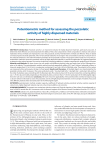
Potentiometric method for assessing the pozzolatic activity of highly dispersed materials
Статья научная
Introduction. Pozzolatic activity is an important indicator for highly dispersed materials, particularly clay soils. It determines their effective use and characterizes the ability of the active components in their composition to interact with calcium hydroxide. Various methods are employed to assess this pozzolatic activity. Potentiometric methods are effective. They are based on measuring the electrode potential, which is functionally related to the change in the concentration (activity) of calcium ions in the analyzed solutions as the main information parameter of the pozzolatic reaction. The purpose of the research is to test the potentiometric method to assess the pozzolatic activity of highly dispersed materials, as well as the application of suggested approach to determine the rational amount of an active mineral lime-containing additive as a binder component for producing soil-concrete. Materials and Methods. We have chosen clay soil models with different plasticity index and sandy loam of the Arkhangelsk region as the objects. The potentiometric analysis method involved sequentially adding 0.015 mol/l calcium hydroxide solution, in amounts ranging from 0.2 to 0.8 ml, to a suspension containing 0.5 g of soil in 80 ml of distilled water. The potential of the system was measured while continuously stirring at a fixed speed. Results and Discussion. All studied objects are characterized by the pozzolatic activity, which increases in the series sandy loam sandy → clay loam light silty → clay light silty ≈ sandy loam silty and has the order of absolute values coinciding with the literature data. The rational amount of the active mineral lime-containing additive was 1–2% for clay soil models, depending on the plasticity index, and more than 2 % for the sandy loam of the Arkhangelsk region (from the soil mass on dried basis). Conclusion. We have shown the applicability of the potentiometric method of analysis using a calcium-selective electrode to assess the pozzolatic activity of highly dispersed materials on the example of models of clay soils with different plasticity index and sandy loam of the Arkhangelsk region.
Бесплатно
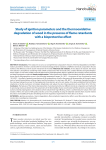
Статья научная
Introduction. This study aims to carry out comprehensive comparative research of thermal degradation and inflammation parameters of timber covered with fire resistant biological flame retardants of different chemical composition. We also looked at the efficiency and the action mechanism of the latter. Materials and methods. As the objects of research, the means were selected – phosphorase-containing water-soluble compounds of the nanoscale series, complex biocides and special bioplasticizers (Agent 1) and water-soluble nanoscale diammonium hydrophosphate (Agent 2) applied to pine wood by surface treatment and deep impregnation methods. Results and discussion. Thermogravimetric studies of wood treated with flame retardants have shown that its decomposition occurs in the following temperature ranges: 30–150°C – the process of loss of moisture by wood; 150–400°C – the effect of protective mechanisms of the compositions, as well as the process of decomposition of the main components of wood (hemicellulose, cellulose, lignin) and the formation of a coke layer; 400–800°C – the process of gradual burnout of the coke layer taking into account its thermophysical characteristics up to the ash residue. It has been established that both flame retardants act by the mechanism of catalytic dehydration and reduce the rate of decomposition of wood from 29 to 10%/min. Conclusion. The features of the thermal decomposition of wood protected by two different chemical composition and method of its processing means are determined. The parameters of the flammability of pine wood treated with fire-protective compounds by surface and deep impregnation were obtained, which indicate their high efficiency, which is confirmed by the values of the coke residue at 400°C, the nature of DTG peaks and DSC curves. The possibility of using the obtained materials from wood for interior decoration and cladding of facades of buildings that meet regulatory requirements for their safe use is shown.
Бесплатно

